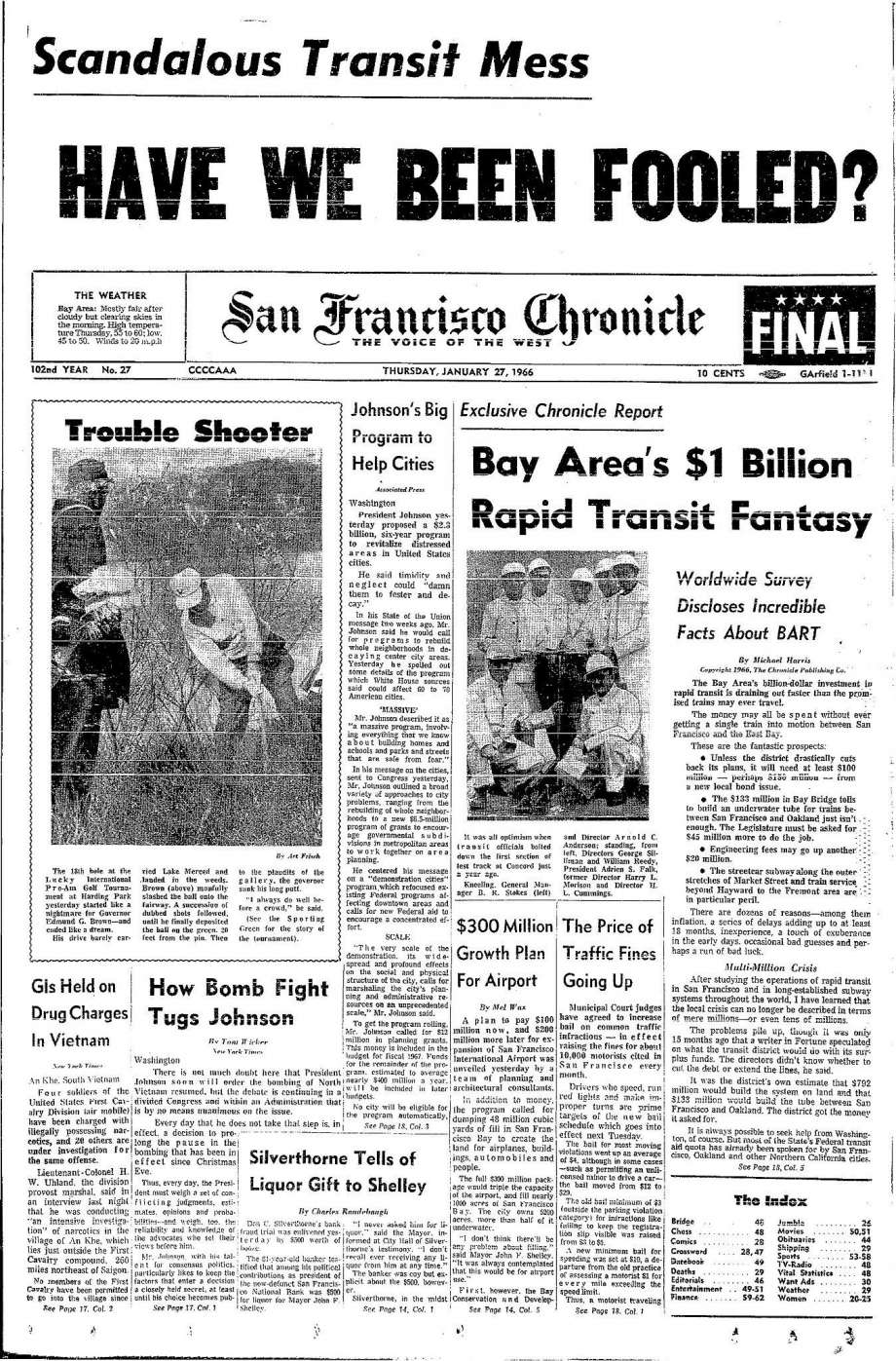"Have we been fooled?" asked the headline of the January 27, 1966 edition of The San Francisco Chronicle. The lead story on that day: how BART was a "Rapid Transit Fantasy." The reproduced cover, seen in the lead image, was part of a recent nostalgia piece by the Chronicle.
The parallels between last week's Mercury News editorial on High-speed rail, which calls on lawmakers to "Stop the California bullet train in its tracks," and the 1966 Chronicle piece on BART's construction cost overruns were not lost on State Senator Scott Wiener. Here's his tweet:
.@mercnews isn’t 1st paper to insist on killing critical transit project due to cost increases. In 1966 (per this cover), @sfchronicle said kill BART due to high costs. Imagine Bay Area today w/o BART. Then imagine CA with 10M more people w our already-strained freeways/airports. pic.twitter.com/QA4uPnJMRU
— Scott Wiener (@Scott_Wiener) January 28, 2018
BART was the subject of an investigation headed by Michael Harris, an "...award-winning political reporter," wrote the Chronicle's Tim O’Rourke, in Sunday's article about the 1966 cover story, adding that: "The Bay Area Rapid Transit planning team had seen costs rise over estimates in the 1960s and by 1966 it was clear the system would need to procure more funds to complete the unprecedented project."
Unprecedented? BART is, after all, just a rapid transit system; even in 1966, there were already similar systems all over the world, just not in California. And today, there are high-speed rail systems all over the world, just not in California. Note that $1 billion in 1966 was equivalent to nearly $8 billion in current dollars. California HSR's overrun on the connection to San Jose is $2.8 billion.
Wiener goes on to point out that "Had this Merc News's flawed logic prevailed in 1960s - i.e. if costs increase on critical transit project, then kill the project no matter what its benefits - we wouldn’t have BART. We need statewide rail in CA."
By the way, BART is hardly the only project that was nearly killed by naysayers. In the 1930s, there were vehement objections to the Golden Gate Bridge. "Critics depicted the bridge as financially unsound, legally dubious, an aesthetic blight and an engineering hazard in the decade before the start of construction in 1933," wrote the SF Gate in a 2012 nostalgia piece. And it's not just the Bay Area; all over the world, public works projects that are now part of the fabric of societies were often derided by the naysayers of the period--that includes everything from the Transcontinental Railroad to the Eiffel Tower.
As Streetsblog pointed out in a previous post, this recent HSR overrun is serious. But considering the experience of the Bay Bridge, and various airport and freeway projects, it's hardly unique. The real question is, can California build anything without going over budget and behind schedule?
"Had legislators and NIMBYs not meddled with CaHSR, more construction could have been achieved earlier in the decade and at a lower cost. The long delays in land acquisition in the Central Valley have taken a major toll," wrote Robert Cruickshank, an HSR activist and blogger, who has long followed the project. "Building the system piecemeal has always been the number one threat." Cruickshank points out that with a GDP of $2.5 trillion, larger than nations that have funded their own successful HSR systems, the state can clearly afford to finish the project, even if it costs more than planned.
Or as Wiener puts it, by all means, "Yes let’s audit, but let’s not kill the train."





